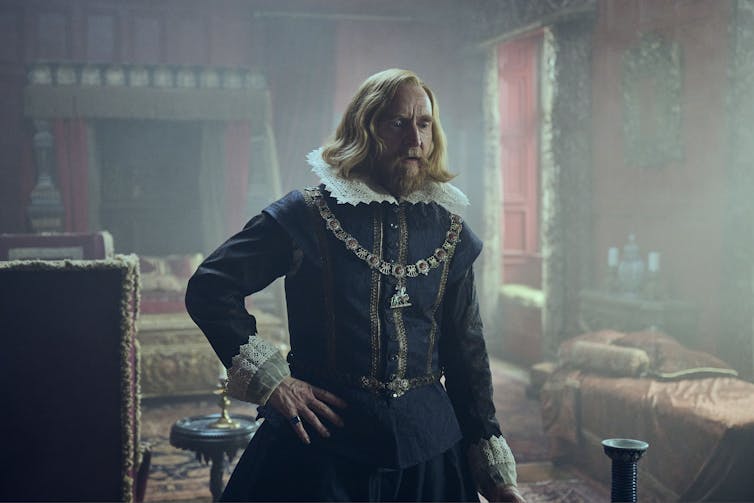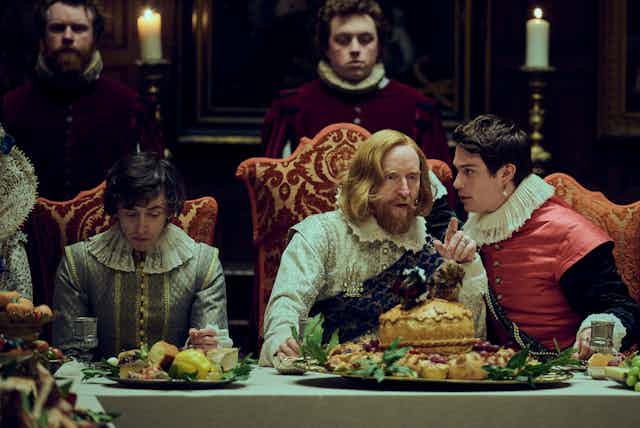The Sky TV series Mary & George tells the story of the Countess of Buckingham, Mary Villiers (Julianne Moore), who moulded her son George (Nicholas Galitzine) to seduce King James I. She believed that, as the king’s lover, her son could become wealthy and wield power and influence.
No one identified as a “homosexual” in King James’s time (1566-1625). The word was only coined in the Victorian period and sexuality was not used to construct identities as it is today.
There was also a more fluid concept of gender. Male and female bodies were seen as fundamentally the same, with sexual differences determined by the way bodily humours (fluids) flowed through them.
A man who desired sex with other men was seen as having an imbalance in his humours – and was blamed for failing to control it.
Sexual acts between men were forbidden by the church, citing passages from the the Bible. Corinthians 6:9 classed the “effeminate” and “abusers of themselves with mankind” among the “unrighteous” who would not inherit the kingdom of God.
The puritan theologian William Perkins, writing in 1591, itemised “strange pleasures about generation, prohibited in the word of God”. This included sexual acts with beasts, devils and members of the same sex.
It was sometimes thought that men who had sex with men would give birth to monsters. Sodomites (people who engaged in anal sex) were said to be the offspring of witches having sex with devils.
Sodomy on trial
Originally under the jurisdiction of the church courts, in 1533 sodomy or “buggery” became a secular crime subject to the death penalty. The offender “not having God before his eyes” was said to have “devilishly” and against “almighty god” and the “order of nature” committed the “destestible” sin of sodomy “not to be named amongst Christians”.
This sort of phrasing was usually reserved for the most heinous offences such as witchcraft, blasphemy and treason.
In early modern southern Europe, hundreds of men were tried and executed for sodomy. But in northern Europe, very few cases were prosecuted.
Low rates of prosecution can indicate one of two things. Either an unwillingness to prosecute a crime, or that the crime occurred infrequently.
Historian Alan Bray argues that, in this instance, it indicates a lack of interest in prosecuting homosexual acts and thereby a degree of tolerance – particularly for acts that did not involve penetration.

Early modern historian Noel Malcolm offers a different explanation. He suggests that the higher rates of prosecution in southern Europe reflect a greater prevalence of homosexual acts involving men who were otherwise heterosexual by preference there.
It is a bold thesis, but is it correct? The low rates of prosecution for sodomy in England follow a comparable pattern to those for rape – so infrequently prosecuted that it’s hard to believe that either represents their actual incidence. Both often involved accusations by a person of lower status against someone in authority.
Jurors were reluctant to convict sexual crimes which carried the death penalty. There was also an inclination to doubt the credibility of victims. This discouraged accusations. In a 1622 case from Somerset, sex crimes involving multiple unwilling partners had been going on for 14 years before victims came forward.
The rarity of sodomy cases, and the sparse detail given in most English legal records, makes it difficult to conclude much about queer sexual practices.
A Sussex clergyman and an Essex schoolmaster were accused in the late Elizabethan period. A coxswain on an East India ship who “committed buggery” with a ship’s boy in 1609 was tried at sea and hanged.
A steward who had sexual contact of a different sort with the same boy was merely whipped. In another naval case from 1638 the offender was imprisoned but eventually pardoned.
Accusations of sodomy were also used to attack religious opponents. Protestant polemicist John Bale made a “catalogue of sodomites” supposedly discovered in Henry VIII’s monasteries.
An anti-puritan publication of 1633 claimed that theologian John Calvin fled to Geneva not on account of religious persecution, but because he had been charged with sodomy in France. In the 1630s, puritans in Sussex framed the traditionalist vicar of Arlington, John Wilson, for supposedly attempting to “commit buggery” with three men and a mare.
King James’s relationships
But it wasn’t all negative. Growing up in the all-male environments of school, university and inns of court, it was seen as normal for the most intense emotional relationships of elite males to be with other men.
In the late 1500s, the French essayist Michel de Montaigne wrote of his friend Étienne de la Boétie: “If you press me to say why I loved him, I can say no more than because he was he, and I was I.”
Philosopher and statesman Francis Bacon considered heterosexual love a “weak passion” compared to the love between male friends. Bacon apparently preferred the “Ganymedes” (Ganymede was a mythological beautiful boy abducted by Zeus) among his servants to his sexually frustrated wife. But he was never prosecuted.
When it came to powerful man like Bacon, and perhaps with lesser mortals as well, it seems that while people didn’t approve of his sexual inclinations, they were willing to ignore them.

As to what King James I got up to sexually with his male favourites in his bedroom, historians can never be sure. The stories of his Ganymedes which abounded after his death could simply reflect prejudice against him as a Scottish foreigner, or distaste at his extravagance towards his favourites. They may be a misreading of his physical demonstrativeness with friends, which shocked his wife Anne when she first met him.
Though we don’t know the truth about his sexual preferences, we do know that James had three intense and exclusive romantic affairs with men. It’s possible that they had a sexual side, just as it’s possible that had he lived today, he wouldn’t have defined himself as heterosexual.
Instead, shaped by his time, in his book Basilikon Doron (1599), James classed sodomy with witchcraft and murder as unforgivable crimes. It must have required some degree of hypocrisy – or cognitive dissociation – for him to square this statement with his own desires. But he probably thought the rules did not apply to him: it was a maxim in law that the king could do no wrong.

Looking for something good? Cut through the noise with a carefully curated selection of the latest releases, live events and exhibitions, straight to your inbox every fortnight, on Fridays. Sign up here.

